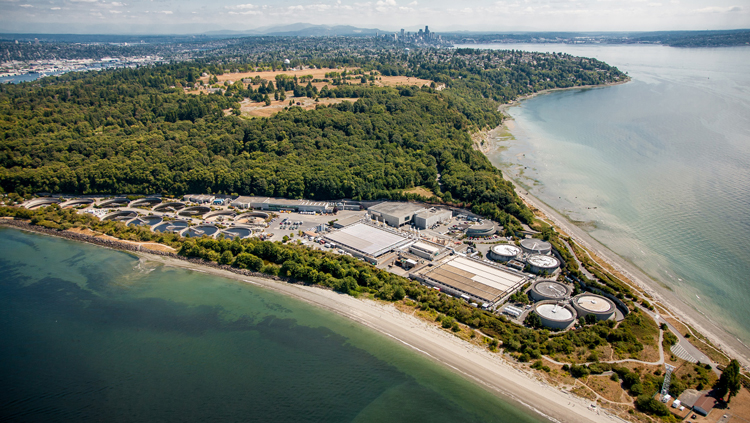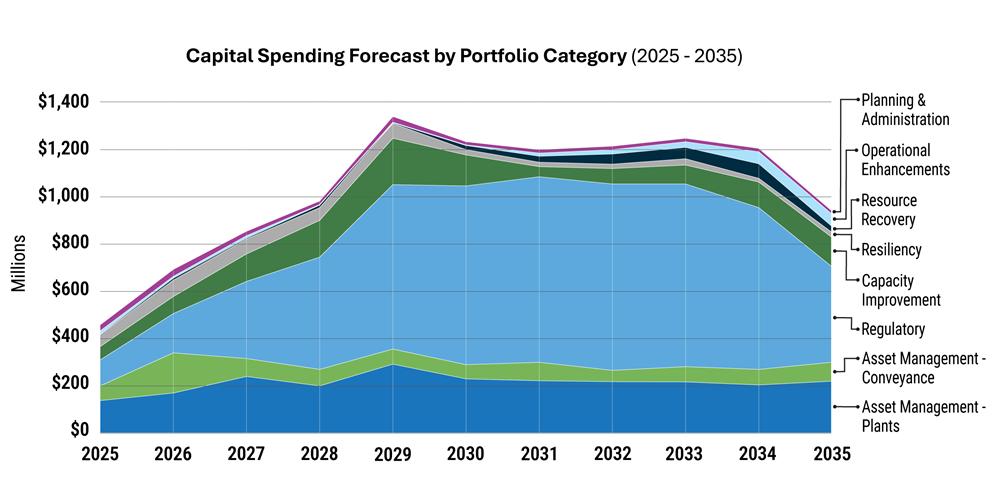Investing in clean water
Wastewater infrastructure is crucial for protecting water quality in Puget Sound and in other water bodies like lakes and rivers, and for maintaining the region’s health and economic vitality. King County is committed to providing excellent service and using public ratepayer funds responsibly and cost-effectively to achieve the best results for water quality. King County's wastewater utility is almost entirely funded by the ratepayers who pay for the costs of our services and programs through their monthly sewer rate.

We are investing approximately $11 billion over the next decade to comply with state and federal regulations, serve the needs of new growth, and renew and upgrade our aging infrastructure. Some of our infrastructure dates back more than 60 years. These are important investments in clean water. We are continuing to explore cost-effective approaches that maximize improvements to water quality.
Sewer rate forecast
We plan our finances several years in advance to manage the annual wholesale costs passed to ratepayers through the local sewer utilities. Our long-term sewer rate forecast shows a substantial rise in rates, potentially doubling in the next six years. This is due to a “stacking effect” as multiple cost-drivers, largely driven by clean water federal and state regulatory requirements, take fuller effect. The forecast is for planning purposes only and is subject to change.
We recognize that increasing sewer rates add to the already high cost of living in the Puget Sound region and that they affect low-income households the most. We continue to have discussions with decision-makers and other groups across the region about how we can address the growing burden of utility costs. In November 2025, King County and Sound Cities Association hosted a Utility Rate Summit and brought together more than 150 elected officials, regulators, and public works managers to develop a path that both protects the natural environment and reduces the burden on homeowners.
Total revenue requirement and resulting sewer rate (2025 - 2035)
The graphic below shows the projected revenue our utility needs in order to cover all its capital and operating expenditures. Those expenditures are what drive the increase in WTD’s wholesale sewer rate over the next decade, impacting the treatment portion of the sewer bills that come from the local sewer service provider to households and businesses in our service area. As shown in the graphic, the main driver for the King County rate charges to the local agencies is funding new capital projects, both by repaying new debt and making direct cash contributions. Operating and maintenance expenses will increase steadily, but as a share of total costs are decreasing over the next 10 years. These estimates are forecasted based on long-term projection of costs and will change year to year as anticipated costs are revised.

Capital spending forecast by portfolio category (2025 - 2035)
The graphic below shows the cost drivers of our capital improvement program. The largest category of spending is regulatory requirements (in medium blue). These reflect our legal obligations to comply with state and federal clean water regulations, such as building projects to control King County’s remaining combined sewer overflow (CSO) outfalls. Other categories, such as Asset Management (medium green and dark blue), reflect the need to replace our aging infrastructure, including conveyance pipes and equipment at the treatment plants, so that users of the system can continue to have reliable, high-quality sewer services. These two categories alone reflect the bulk of the new expenditures driving the revenue requirements in the sewer rates.

| Category | Description |
|---|---|
| Asset Management Plants and Conveyance | Maintain level of service through the rehabilitation or replacement of critical assets. |
| Capacity Improvement | Increase capacity in WTD facilities to accommodate future growth. |
| Operational Enhancements | Reduce/improve operating costs at treatment plants through the delivery of projects that create efficiencies. |
| Regulatory | Deliver projects and programs that respond to permit, regulation, and/or consent decree legal deadlines. |
| Resiliency | Improve the survivability and operability of core assets against natural disasters through the delivery of projects that address known deficiencies. |
| Resource Recovery | Support King County’s climate goals through the delivery of projects that reduce energy use or recover valuable resources from wastewater. |
| Planning and Administration | Incorporate programs and projects that facilitate execution of the overall capital portfolio through a series of planning- and administration-related efforts. |
Financing investments
Through strong fiscal stewardship, we have continued to earn high credit ratings in the bond market and secure low-interest loans from federal and state sources. We’ll continue to look for ways to make the most of every dollar.
Standard & Poor's and Moody’s investor services are leading global financial firms that rate corporate stocks and municipal bonds according to risk profiles.
- King County Sewer Enterprise parity sewer revenue bonds ratings of Aa1 from Moody’s Investors Services (Moody’s) and AA+ from Standard and Poor’s (S&P) Global Ratings were affirmed in October 2025. Its junior lien sewer revenue bonds ratings of Aa2 from Moody’s and AA from S&P Global Ratings were also affirmed in October 2025.
- King County Sewer Enterprise limited tax general obligation bonds (LTGO) of AAA from Moody’s and AAA from S&P Global Ratings were affirmed in March 2025.
These continued favorable credit ratings lower the cost of borrowing by reducing interest payments to bondholders, which, in turn, reduces impacts to the sewer rate.
Financial statements
The wastewater utility undergoes an annual audit to ensure that its annual financial results are fairly stated and that all covenants with the utility’s bondholders have been met. View audited financial statements.
Executive Proposed Biennial Budget (2026-2027)
- Operating budget: $503 million
- Capital budget: $1.3 billion
FAQ
The “monthly sewer rate” is what King County charges local contract sewer agencies (i.e., cities, special purpose districts, and the Muckleshoot Tribe) for each single-family residence or for each 750 cubic feet of monthly water use from multi-family residences and commercial customers. A household bill includes both the King County rate and the costs incurred by the local contract sewer agencies. Most agencies represent the wholesale monthly sewer rate as a pass-through on customers’ bills. Other billing approaches for agencies such as the City of Seattle are blended into a rate structure and don’t distinguish the King County portion (i.e. Seattle households sewer service is charged based on winter average water use).
King County’s wholesale sewer rate for a single-family residence is increasing from $58.28 in 2025 to $62.66 in 2026, a 7.5% increase. As explained above, the sewer bill received by each household also includes the costs of their local contract sewer agency, which vary by service area. On average, King County’s wholesale rate represents 60% of a customer’s sewer bill.
King County is making major investments in the regional wastewater system to comply with regulations that improve water quality, to replace aging infrastructure some of which dates back to the 1960s, and to add capacity for new growth in our region. These costs fall almost entirely on local ratepayers. We continue to advocate for more federal and state funding and explore cost-effective approaches that maximize improvements to water quality.
The King County Executive submits their sewer rate proposal to the King County Council each spring. The council deliberates and is required to adopt a sewer rate by June 30 for the following year.
As part of the process to develop the rate proposal, WTD engages with contract agencies through the Metropolitan Water Pollution Abatement Advisory Committee (MWPAAC) and the Regional Water Quality Committee (RWQC). Presentations and discussions at these meetings include rate-setting methodology, cost drivers and assumptions, and capital program needs and forecasting.
King County Wastewater Treatment Division is implementing a number of changes to the sewer rate setting process to continue to improve transparency and accountability. Among these changes are longer timeframes for in-depth review and understanding of costs, earlier visibility into large capital projects, multiyear predictability in rates, and independent third-party oversight of the capital program. Additionally, we are meeting with representatives from other regional utilities across the region to address broader affordability challenges and are developing strategies to better inform ratepayers about rising costs.
King County’s regional wastewater utility runs on only revenues from the rates we charge our customer agencies, capacity charge revenue, industrial waste fees, and other miscellaneous utility revenue. The utility receives no tax revenue sources for wastewater collection, treatment, and reclamation.
Depending on the size and timing, a project can have a significant impact on the sewer rate. The Mouth of Duwamish Wet Weather Facilities is one of WTD’s largest projects—its cost is currently estimated at $3.4 billion over the next 10 years. The Wastewater Treatment Division’s funding strategy relies in large part on debt financing, which helps to spread these costs over a longer period of time and across current and future ratepayers. The sewer rate charged by King County to contract agencies needs to cover both operating costs and the debt service payments.
The WTD CIP is funded through a combination of debt (long-term revenue bonds and federal and state loans) and cash transfers from the operating fund that include capacity charge revenues. WTD’s debt is usually repaid over 30 years, similar to a home mortgage. The operating fund derives the majority of its revenue from monthly charges to sewer customers that are collected by WTD's contract agencies.
WTD balances the use of cash and debt to ensure financial sustainability, intergenerational equity, and sewer rate stability. In the current forecast, WTD expects to cash-fund approximately 30% of its capital spending and pay for the remaining 70% with debt.

 Translate
Translate